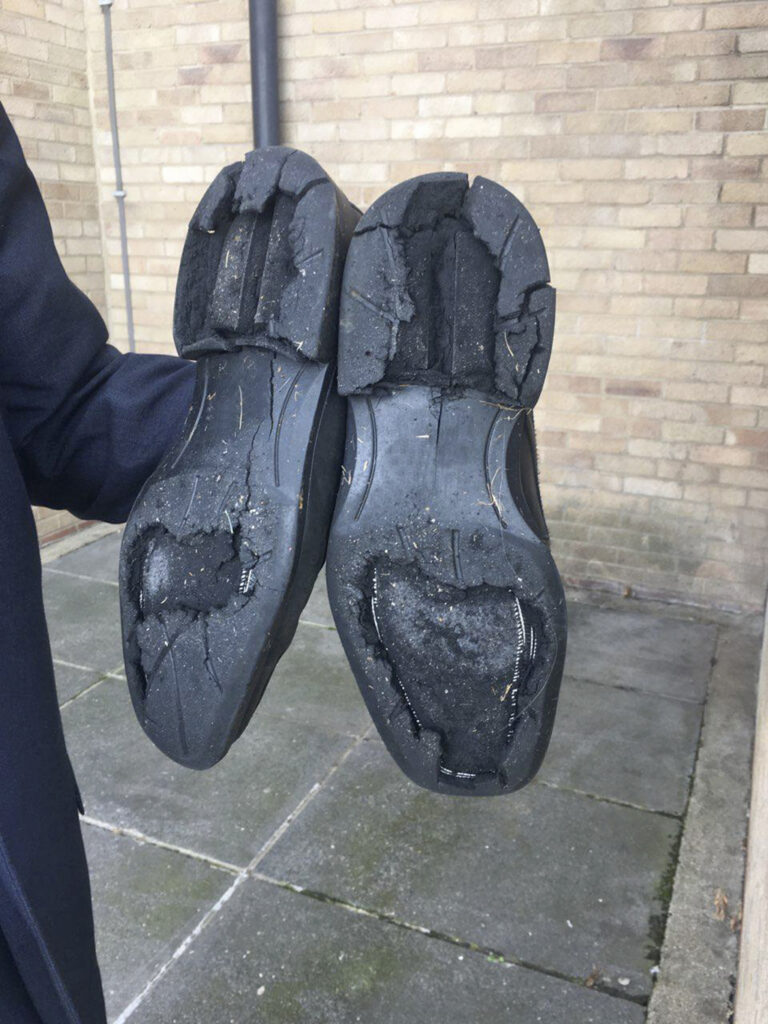
This article from the ‘Warrior ‘ brand of safety shoes highlights the factors that cause shoes to age even if they are not worn regularly
“What is the service life of safety shoes? Why does the sole disintegrate after a certain period of time?” Many users ask these questions. The reason is that different materials in the shoe have different service lives. A shoe consists of various components, some of them being subject to natural decay at some point. This is often dependent on the chemical composition of a material. This composition can produce certain properties, but it can also be the reason why the material has a certain useful life. The material that is responsible for the service life of the majority of our shoes is the polyurethane in the midsole and outsole.
Complaints and, in some cases, alleged quality defects generally reach the manufacturer via its marketing and quality control departments where, taking into account specific issues, experts perform a more detailed analysis in order to identify the cause of the problem. They produce a detailed response based on their findings. Further, manufacturers, for example, even receive complaints about shoe soles having fallen apart immediately, despite infrequent use. The statements made by the users of these shoes are often fairly similar: the shoes were worn extremely rarely and were in fact only stored in the cardboard box for a long period of time.
The users had either taken the shoes shown in the photos out of the box in this state, or they had fallen apart straightaway while wearing them. You should also know that the shoes shown are no longer the latest models. The age of the shoes from their date of manufacture ranges between at least two years and a maximum of five years. So, why do shoe soles disintegrate? Some of you have no doubt got shoes in your wardrobe of a similar age which are still good to wear. The reason for this is the aforementioned polyurethane (PU) sole material.
Polyurethane (PU) is frequently used in safety shoes as it offers several positive properties, such as:
• Very light
• Very flexible
• Very good shock-absorbing properties
• Highly abrasion-resistant
• Good anti-slip properties.
All of this has a very beneficial effect on the user’s natural movement patterns and also when it comes to the product life of the sole as regards mechanical influences. The specific composition of PU produces these material qualities, but it also affects the service life of the material. Above all, the PU sole material is subject to a natural ageing process – hydrolysis. What happens when soles age? PU consists of long polymer chains that are gradually split apart due to the effect of moisture. As a consequence, PU loses flexibility over time and gradually becomes brittle.

As the shoes reach an advanced age, this can lead to signs of disintegration in the soles. But why can storing shoes often be more detrimental to their useful life than if they are worn? Work shoes are often stored in the basement, shed or garage – places where poor sunlight and higher levels of moisture are normally present. And it is precisely this moisture that amplifies the hydrolysis process and causes the shoes to age even more quickly, even though they are not actually being worn.
Recommendations for Safety Shoes
Ageing of safety shoes is an entirely normal process that all shoes go through. If we want to benefit from all the positive properties of a safety shoe, we need to be aware of the limited product life of shoes. We recommend adoption of ‘first in-first out’ during storing and distribution and regular use by user. Due to long storage, the shoe sole gets weak and loses its properties so that it does not last long. Further information can be found in the maintenance tips leaflet that comes with every ‘Warrior’ safety shoe and on the company’s website www.warrior.co.in.